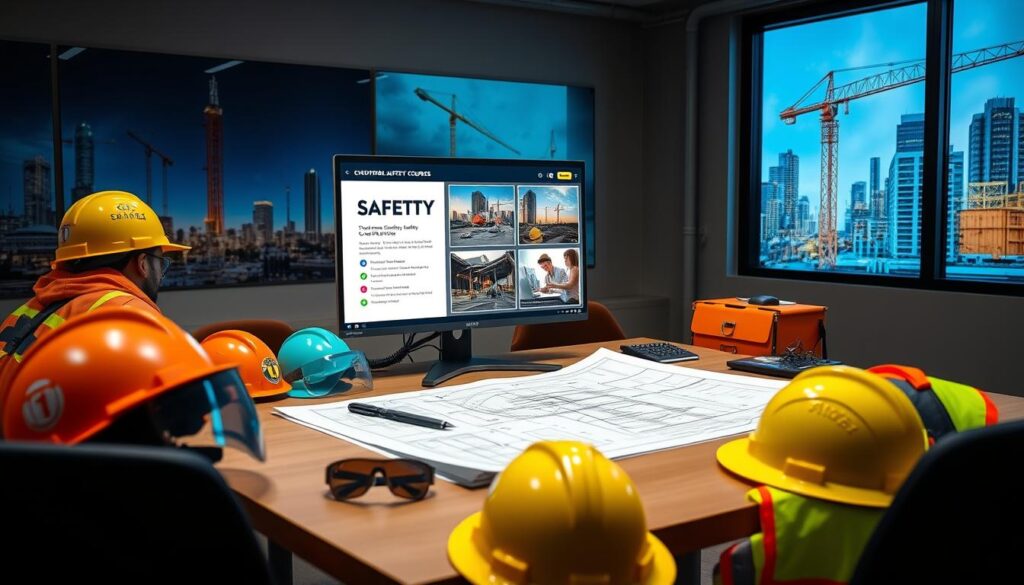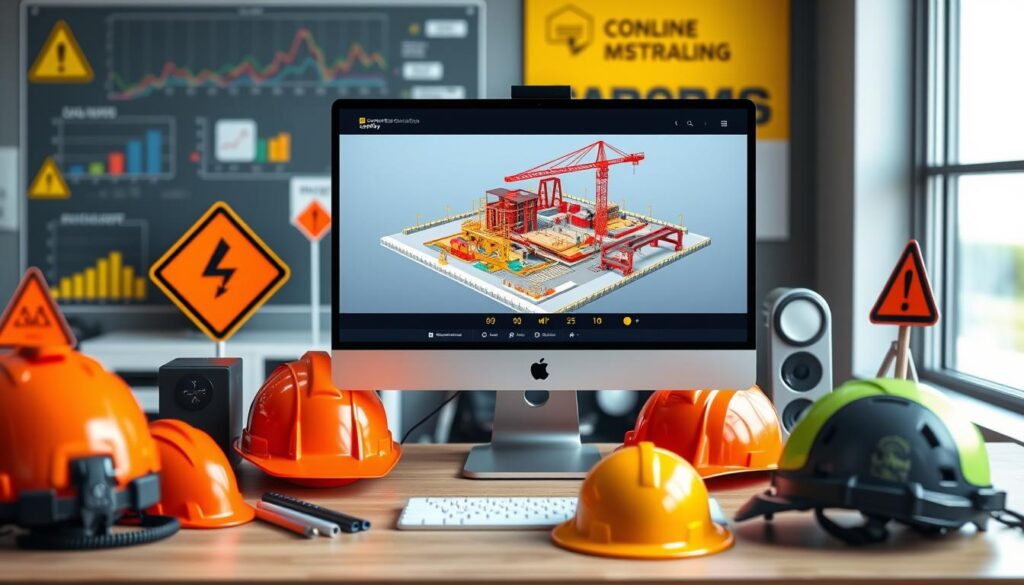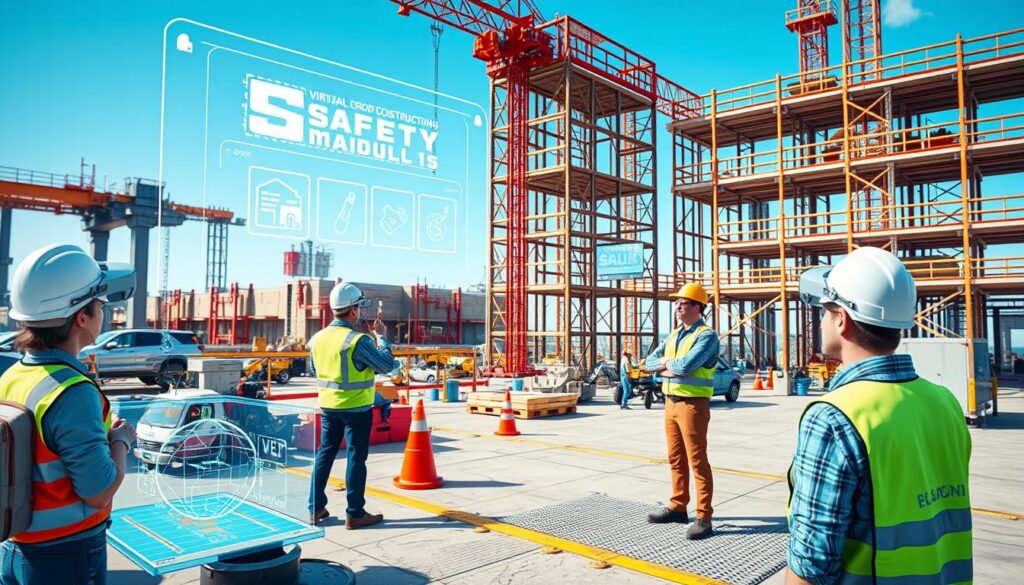In Canada, the construction sector’s safety is paramount. The industry’s rapid evolution underscores the need for thorough safety training.
This article will highlight the top online courses for construction safety in 2025. These resources are designed to keep workers safe and informed.
The construction field is increasingly adopting digital learning. Online courses offer a flexible way for professionals to improve their safety knowledge.
This article will discuss the significance of safety training, current standards, and the advantages of digital learning. It will also cover the best Regulator-approved certifications and courses for 2025.

Moreover, we’ll look at interactive platforms and simulation tools that are changing safety training. By the end, you’ll have the tools to choose the right safety training for workers. This will prepare workers for the challenges of the construction site in 2025 and beyond.
Understanding the Importance of Construction Safety Training Online
In Canada’s dynamic construction sector, worker safety is paramount. Virtual construction safety programs and digital education have become essential. Let’s delve into the current safety standards, the advantages of digital learning, and the significant impact of safety training.
Also Read: Online Safety Training in Canada
Current Industry Safety Standards
The Canadian construction industry follows strict safety standards. These are set by bodies like the Canadian Centre for Occupational Health and Safety (CCOHS) and provincial/territorial Occupational Health and Safety (OHS) agencies. These standards cover a broad spectrum, from the use of personal protective equipment (PPE) to on-site risk assessments.
Benefits of Digital Learning in Construction Safety
- Flexible and accessible training for workers, allowing them to learn at their own pace and convenience
- Cost-effective implementation of safety programs, reducing the need for in-person training sessions
- Real-time data tracking and analytics to monitor the effectiveness of safety initiatives
- Seamless integration of virtual and augmented reality (VR/AR) technologies for immersive safety simulations
Statistics on Safety Training Impact
Studies have shown the positive effects of virtual construction safety programs and digital education. A recent report found that companies with comprehensive online safety training saw a 25% drop in workplace incidents. They also experienced a 35% boost in safety culture among their workforce.
| Metric | Improvement |
| Workplace Incidents | 25% Reduction |
| Safety Culture | 35% Improvement |
These figures highlight the crucial role of digital learning in creating a safer construction environment. It empowers workers with the knowledge and skills to reduce risks and protect themselves at work.
Also Read: Why Respirator Fit Testing is Crucial for Worker Safety

Best Online Courses for Construction Safety: 2024 Edition
In the ever-evolving landscape of construction site safety, staying ahead is crucial. As we approach 2025, a variety of online courses lead the way in training and certification for construction pros. From foundational safety modules to advanced certifications, and specialized e-learning modules, the choices are vast.
Specialized Safety Training Modules
The industry offers specialized online courses for specific needs. These include:
| Course | Focus Area | Certification |
| Confined Space Entry and Rescue | Hazardous Environments | Industry Recognized |
| Crane and Rigging Safety | Heavy Equipment | Industry Recognized |
| Fall Protection and Prevention | Working at Heights | Industry Recognized |
Investing in these top-tier online courses helps construction pros meet industry standards. It reduces risks and ensures the safety of their teams on-site.

Virtual Construction Site Risk Management Programs
In the construction safety realm, online courses are changing how professionals manage site risks. These virtual programs offer more than traditional classroom learning. They provide an immersive experience, preparing workers for construction site hazards.
The Online Construction Risk Management Training course dives into risk assessment and mitigation. It uses interactive case studies and real-world scenarios. Participants learn to spot threats, create emergency plans, and implement safety measures.
Also Read: What is Fall Protection?
The Virtual Construction Site Emergency Preparedness Training focuses on quick and effective emergency responses. It simulates crisis situations, teaching participants to make decisions and coordinate responses. This helps reduce the impact of unexpected incidents.
These virtual programs improve worker safety and project efficiency. By addressing risks early, construction companies avoid delays and maintain a good reputation. This proactive approach ensures safer and more productive projects.
| Course | Key Features | Learning Outcomes |
| Online Construction Risk Management Training | Interactive case studiesReal-world scenario simulationsRisk assessment and mitigation strategies | Identify potential construction site hazardsDevelop comprehensive emergency preparedness plansImplement effective control measures to ensure safety |
| Virtual Construction Site Emergency Preparedness Training | Simulation-based crisis scenariosCoordination of emergency response protocolsMinimizing the impact of unforeseen incidents | Respond swiftly and effectively to onsite emergenciesMake informed decisions during crisis situationsMaintain project continuity and minimize disruptions |
These online courses are revolutionizing construction site risk management. They empower professionals to create safer work environments. By using virtual learning, the industry is setting a high standard for construction site safety.
Also Read: Can Safety Orientation Videos in Workplace Reduce Injuries?
Interactive Learning Platforms for Construction Hazard Prevention
In the ever-evolving landscape of construction safety, innovative digital tools are revolutionizing how workers engage with and retain vital safety information. The industry is embracing interactive learning platforms. These platforms enhance worker engagement and dramatically improve hazard recognition and prevention skills.
Simulation-Based Training Tools
Cutting-edge simulation-based training tools provide construction workers with realistic, interactive scenarios that mimic on-site hazards and challenges. These platforms allow workers to experience and navigate through potential dangers. This strengthens their ability to identify and respond to risks in real time.
Also Read: Why Sitedocs is one of the Preferred Safety Management Systems?
By blending interactive simulations with detailed instructional content, these tools effectively bridge the gap between theoretical knowledge and practical application. They equip workers with the confidence and competence to prioritize safety on the job.
Virtual Reality Safety Scenarios
The integration of virtual reality (VR) technology into construction safety education has ushered in a new era of immersive learning. VR-based safety scenarios transport workers into lifelike construction environments. Here, they can explore, identify, and address a wide range of potential hazards.
This hands-on, interactive approach enhances engagement and helps to ingrain critical safety behaviors and decision-making skills. It ultimately reduces the likelihood of on-site accidents and injuries.
Mobile Learning Applications
The rise of mobile learning applications has brought construction safety education directly to workers’ fingertips. These user-friendly, on-the-go platforms provide access to a wealth of safety resources. This includes interactive quizzes, video tutorials, and real-time alerts.
By empowering workers to access safety information anytime, anywhere, mobile learning apps have become an invaluable tool. They promote a culture of virtual construction safety programs and digital construction worker safety education.
As the construction industry continues to embrace the power of interactive learning, the impact on worker safety and productivity is undeniable. By leveraging simulation-based training, virtual reality, and mobile technologies, construction companies can equip their workforce. They provide the knowledge, skills, and tools necessary to navigate and mitigate hazards.
Ultimately, this creates a safer, more secure work environment for all.
Cost Analysis and ROI of Online Safety Training
In Canada, I’ve witnessed the significant benefits of online construction site safety training for businesses. Analyzing the cost-effectiveness and potential return on investment (ROI) of these digital programs, I conclude that the advantages are substantial. The initial investment is well worth it.
Online courses are more economical than traditional in-person training. They eliminate travel costs and reduce time away from work sites. This makes training more accessible across various locations, lowering costs per employee. The flexibility of on-demand learning also boosts productivity, allowing workers to train at their convenience.
The financial gains from online construction injury prevention courses go beyond initial savings. By equipping workers with safety knowledge, companies can drastically cut down on accidents and injuries. This leads to fewer workers’ compensation claims and lower insurance costs. Many construction firms see a notable return on their investment within the first year.
Conclusion
In 2025, prioritizing construction safety through education has never been more accessible. With a variety of online courses tailored to meet industry demands, professionals at all levels can enhance their knowledge and skills conveniently. Whether you’re a site manager aiming to reinforce compliance or a worker seeking to improve on-the-job safety practices, these courses offer the flexibility and expertise to make a real difference.
Investing in the right training not only ensures adherence to safety standards but also fosters a culture of accountability and care on construction sites. Explore the options listed, choose the course that best aligns with your needs, and take a proactive step toward a safer, more productive future in construction.
